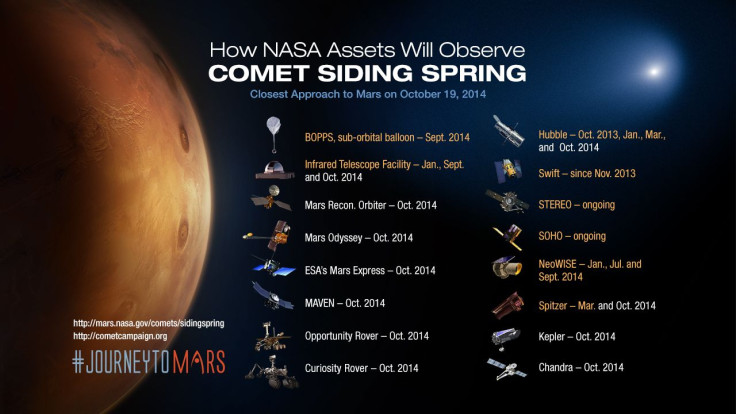NASA Prepares Mars Orbiters And Rovers For Oct. 19 Flyby Of Comet Siding Spring

NASA is preparing its orbiters and rovers on Mars for an unprecedented encounter with a comet as the space projectile is expected to fly by the red planet on Oct. 19. The comet C/2013 A1, also known as Siding Spring, will pass within 87,000 miles of the Martian surface, which is less than half the distance between Earth and the moon.
Siding Spring, travelling at about 126,000 mph, will come closest to Mars around 2.27 p.m. EDT on Oct. 19, providing researchers with the first opportunity to gather data about the comet as well as its effect on the Martian atmosphere. At the time of its discovery, Siding Spring was farther from the Sun than Jupiter is, and was about 7.2 times farther away from the sun than the Earth, according to astronomers.
“This is a cosmic science gift that could potentially keep on giving, and the agency’s diverse science missions will be in full receive mode,” John Grunsfeld, astronaut and associate administrator for NASA’s Science Mission Directorate in Washington, said in a statement. “This particular comet has never before entered the inner solar system, so it will provide a fresh source of clues to our solar system's earliest days.”
The comet has its origin in the Oort Cloud, a hypothetical spherical cloud of icy objects nearly a light-year away from the sun. Scientists believe this region to be a giant swarm of icy objects that are thought to be material left over from the formation of the solar system.
According to researchers, Siding Spring will be the first comet from the Oort Cloud to be studied up close by spacecraft. The experiments are expected to help scientists better understand materials, such as water and carbon compounds, that existed during the formation of the solar system 4.6 billion years ago.
“The period of greatest risk to orbiting spacecraft will start about 90 minutes after the closest approach of the comet's nucleus and will last about 20 minutes, when Mars will come closest to the center of the widening trail of dust flying from the comet’s nucleus,” NASA said, adding that its Mars orbiters will gather information before, during and after the flyby about the size, rotation and activity of the comet's nucleus.
The orbiters will also study the variability and gas composition of the coma around the comet’s nucleus, as well as the size and dust particles in its tail.
The orbital period of Siding Spring has yet to be determined, so its return to the inner solar system cannot be predicted now. However, astronomers believe that the comet is not likely to make a comeback for another million years.
© Copyright IBTimes 2025. All rights reserved.






















